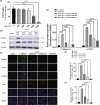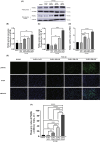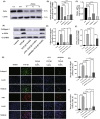SAHA inhibits lung fibroblast activation by increasing p66Shc expression epigenetically
- PMID: 39777101
- PMCID: PMC11702475
- DOI: 10.1002/agm2.12385
SAHA inhibits lung fibroblast activation by increasing p66Shc expression epigenetically
Abstract
Objectives: To investigate the effects of suberoylanilide hydroxamic acid (SAHA) on lung fibroblast activation and to examine the role of p66Shc in this process.
Methods: An in vitro pulmonary fibrosis model was established using transforming growth factor-β (TGF-β)-induced MRC-5 lung fibroblasts. The proliferation and migration capacities of MRC-5 cells, along with the expression of fibrosis-related genes, were assessed following treatment with SAHA and/or silence of p66Shc.
Results: In TGF-β-induced MRC-5 lung fibroblasts, SAHA treatment significantly inhibited cell proliferation and migration, as well as the expression of fibrosis-related genes, including collagen I and α-smooth muscle actin (SMA). Western blot and immunofluorescence assays revealed that SAHA increased p66Shc expression in both whole cells and mitochondria. Additionally, mito-SOX assay confirmed that SAHA treatment led to a marked accumulation of mitochondrial reactive oxygen species (ROS). However, silencing of p66Shc significantly reversed the aforementioned effects of SAHA on MRC-5 cells. Furthermore, chromatin immunoprecipitation (ChIP) assays demonstrated that SAHA enhanced active histone markers, H3K9Ac and H3K4Me3, in the p66Shc gene region.
Conclusions: SAHA alleviates lung fibroblast activation and migration by increasing p66Shc expression and mitochondrial ROS generation through epigenetic modifications of histone 3.
Keywords: SAHA; histone modification; lung fibroblasts; p66Shc; pulmonary fibrosis.
© 2024 The Author(s). Aging Medicine published by Beijing Hospital and John Wiley & Sons Australia, Ltd.
Conflict of interest statement
The authors declare that the research was conducted in the absence of any commercial or financial relationships that could be construed as a potential conflict of interest.
Figures







Similar articles
-
Suberoylanilide hydroxamic acid attenuates epidural fibrosis via inhibiting myofibroblast differentiation and increasing fibroblast apoptosis.Eur Rev Med Pharmacol Sci. 2020 May;24(10):5726-5733. doi: 10.26355/eurrev_202005_21364. Eur Rev Med Pharmacol Sci. 2020. PMID: 32495908
-
Suberoylanilide hydroxamic acid: a potential epigenetic therapeutic agent for lung fibrosis?Eur Respir J. 2009 Jul;34(1):145-55. doi: 10.1183/09031936.00084808. Eur Respir J. 2009. PMID: 19224893
-
Suberoylanilide Hydroxamic Acid (SAHA) Reduces Fibrosis Markers and Deactivates Human Stellate Cells via the Epithelial-Mesenchymal Transition (EMT).Cell Biochem Biophys. 2021 Jun;79(2):349-357. doi: 10.1007/s12013-021-00974-1. Epub 2021 Mar 10. Cell Biochem Biophys. 2021. PMID: 33689126
-
Necrostatin-1 Alleviates Bleomycin-Induced Pulmonary Fibrosis and Extracellular Matrix Expression in Interstitial Pulmonary Fibrosis.Med Sci Monit. 2020 Feb 5;26:e919739. doi: 10.12659/MSM.919739. Med Sci Monit. 2020. PMID: 32019905 Free PMC article.
-
Histone deacetylase inhibition downregulates collagen 3A1 in fibrotic lung fibroblasts.Int J Mol Sci. 2013 Sep 27;14(10):19605-17. doi: 10.3390/ijms141019605. Int J Mol Sci. 2013. PMID: 24084714 Free PMC article.
Cited by
-
The Role of p66Shc in Cancer: Molecular Mechanisms and Therapeutic Implications.J Cell Mol Med. 2025 Jul;29(14):e70737. doi: 10.1111/jcmm.70737. J Cell Mol Med. 2025. PMID: 40690563 Free PMC article. Review.
-
p66Shc deletion confers apoptotic resistance to loss of EGFR-ERK signalling in neural stem cells.Cell Death Dis. 2025 Jul 1;16(1):479. doi: 10.1038/s41419-025-07778-8. Cell Death Dis. 2025. PMID: 40593476 Free PMC article.
References
LinkOut - more resources
Full Text Sources
Miscellaneous
